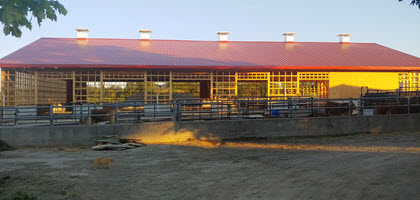John Post’s career as a contractor helped him quickly put together plans to recover from the tragedy
By Jackie Clark
Staff Writer
Farms.com
Wellington County cattle breeder John Post has managed to execute a miraculously quick recovery from a devastating barn fire in early April.
On the evening of April 9 at “about 8 o’clock we saw the fire in the barn,” Post told Farms.com. “We went out to rescue the cattle. Within ten or fifteen minutes the roof had collapsed.”
Post managed to get the cattle to the concrete barnyard, and most of the animals did not suffer much harm.
“From the 45, we did have seven that ended up going to get butchered,” he said.
After the flames were doused, investigators looked for the cause of the fire. “They narrowed it down to the pen (where) the cattle were hurt the worst. That’s where a bunch of wiring was, so it was assumed or determined that rodents (damaged) the wiring,” Post explained. The electrical system in the barn had been completely updated and replaced in 2003.
Immediately, Post had to figure out where the cows and bulls would go.
“The first priority was the health of the cattle. Fortunately it was April,” so the weather allowed for the animals to be housed outside, he said.
“We run a pure-bred Limousin herd,” he explained. “The female stock was not hurt in the fire, which was a real blessing. … If the female herd had been gone, I would have quit. That’s 30 years of bloodlines.”
He placed females and calves in a field near the old barn. Neighbours up the road offered to take the breeding bulls while other arrangements were made. Shortly thereafter, some were shipped home.
“The fire was Thursday night, and by Tuesday we had the bulls back home again,” Post said. The remainder of the bulls were housed in the barnyard.
“The barnyards were cement with divisions in them, so (those areas were) not affected,” he added.
Once the cattle were taken care of, Post turned his attention to rebuilding.
“I was a contractor all my life,” he said. So, he knew organization would be the key to quickly getting the barn back up and running. He planned to rebuild on the same site, and construction began a mere three weeks after the fire.
“Within three days after the fire we had it pretty much cleaned up,” Post said. His sons, who took over his contracting business, then worked on constructing the frame. “They were done about the second week of June.”
Concrete work is underway now.
“We’ll be done hopefully by August first,” Post said.


Pictured above is the original barn. The bottom photo is the new barn Post is building in the same location.
From his contracting experience, he knew how to get all the trades together and coordinate plans and supplies. Also, in the weeks prior to the fire, Post had hurt his knee in the barn. “I was at home and injured so I had lots of time to sit around and do nothing but paperwork,” he said.
Folks he’d known and worked with in the construction business pulled together to help him rebuild.
“I called in a whole bunch of favours,” Post said. “Everybody worked together.”
Post expects to be back to business soon.